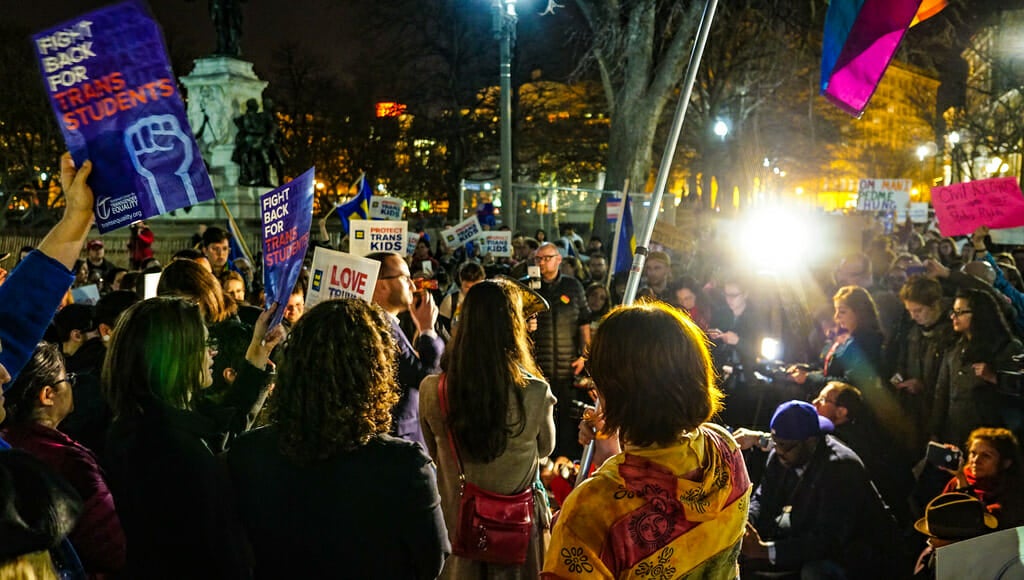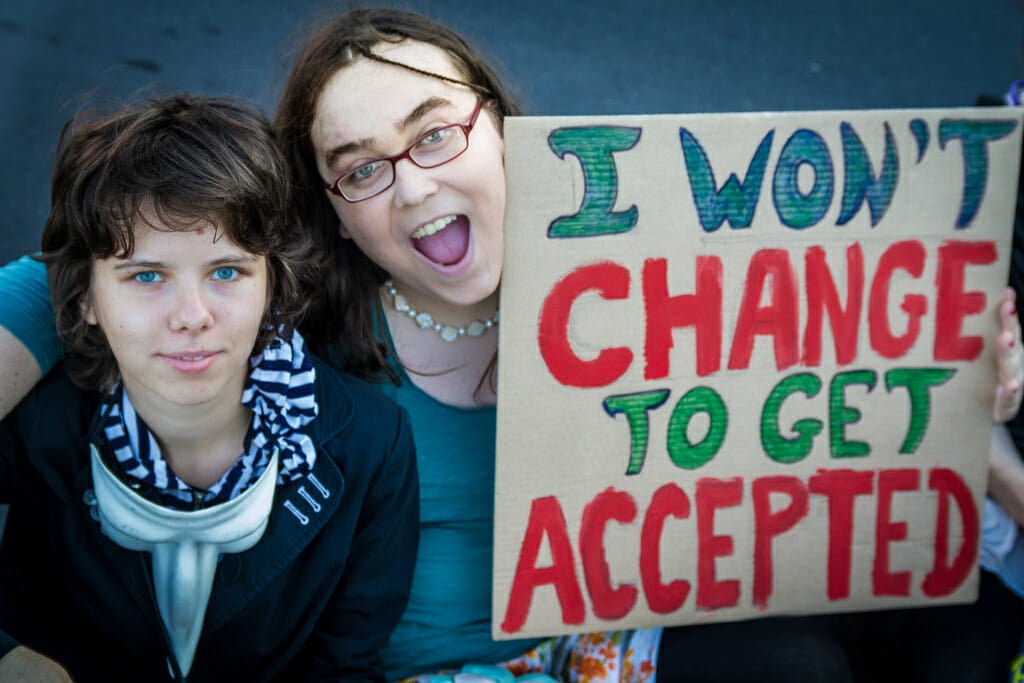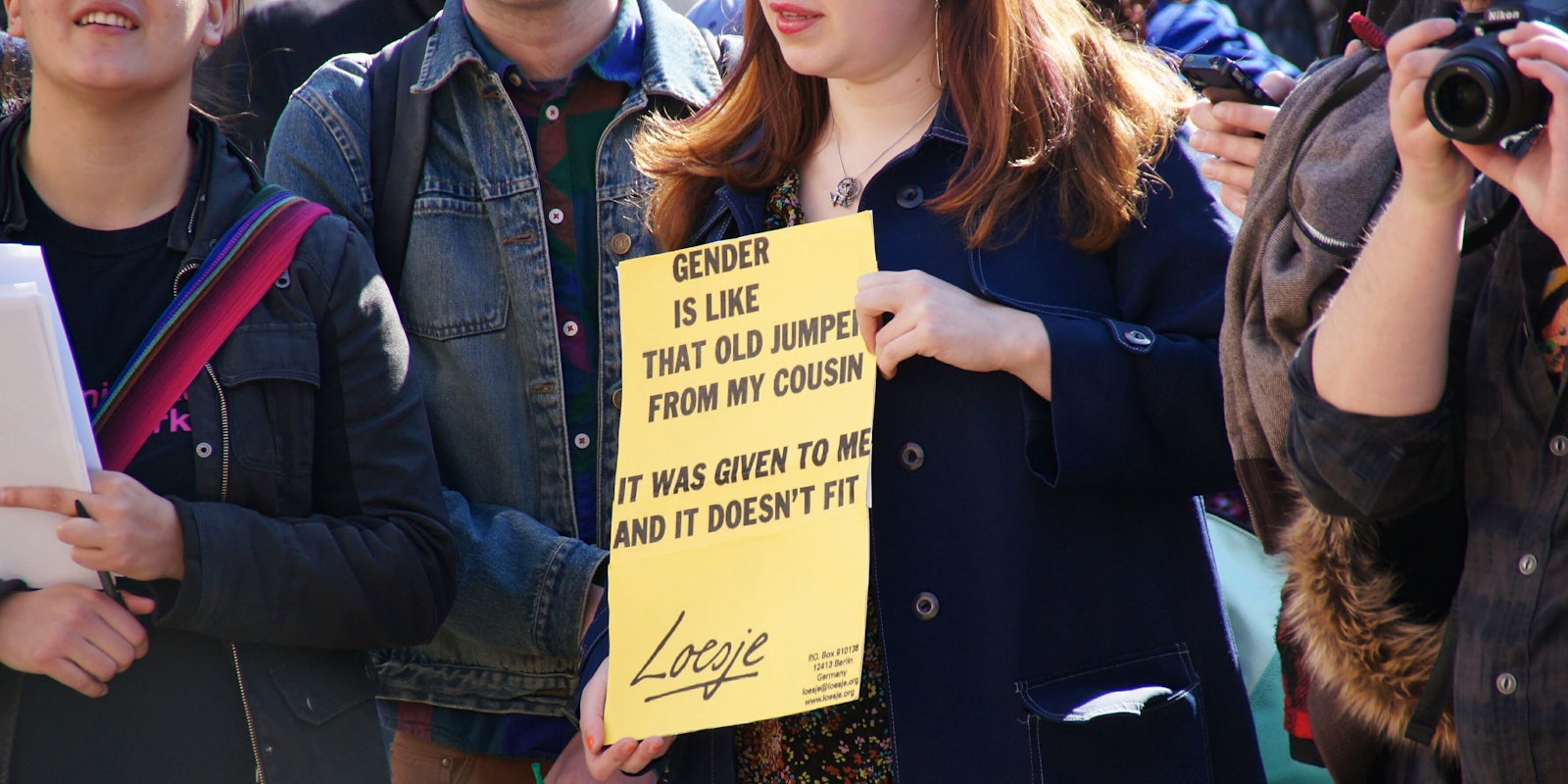According to a 2017 GLAAD study, 20 percent of millennials identify as LGBTQ, as do 12 percent of the population at large. But how many people in the U.S. are transgender?
It’s hard to say. Like early gay, lesbian, and bisexual studies, activists fear that surveys may be underreporting the trans population because trans people may not want to reveal their status on any form for fear of discrimination. For now, all we can do is point to studies and analysis that have been done regarding trans people and the U.S. population. But be aware that there’s a larger story at play behind these numbers.
Transgender population in the U.S.
In the Williams Institute’s 2016 study “How Many Adults Identify as Transgender in the United States?,” the UCLA law school institute reports that there’s a relatively small number of transgender Americans. Approximately 0.58 percent Americans identify as transgender—or over 1.3 million. Meanwhile, GLAAD’s Accelerating Acceptance report shows that 3 percent of the general population directly identifies as transgender among age groups.
While you could argue that trans people may feel more comfortable coming out on a GLAAD survey than they would in a university one, it’s safe to say that the trans population is in the low single digits.
Percentages also vary widely from state to state
So how are trans people spread out across the states? Well, as you could guess, states with larger metropolitan cities are home to more trans people.
According to the Williams study, 2.7 percent of Washington, D.C.’s population is transgender, bringing the total to 14,550. In California, 0.76 percent of the population is transgender, clocking in at 218,400 Americans. Meanwhile, New York has 0.51 percent transgender citizens, New Jersey and Pennsylvania both have 0.44, and Massachusetts has 0.57 percent trans people living in the state.
On the other end of the spectrum, North Dakota and Iowa are the two states with the least transgender Americans, at 0.30 percent and 0.31 percent, respectively. Nebraska clocks in at 0.39 percent, Montana with 0.34 percent, and South Dakota with 0.34 percent. These numbers not only reflect that trans people may flock to cities for acceptance, but that they also still exist in red states but fear coming out because of a lack of acceptance.

Young people report being trans at higher rates
Location aside, other factors are likely to influence trans population stats. For starters, age. According to the Williams Institute, young adults are proportionally more likely to identify as transgender than older generations. Even across states, millennials ages 18–24 unanimously report being trans at higher percentages than Americans ages 25 and older. For instance, 0.84 percent of California adults ages 18–24 identify as transgender, whereas only 0.77 percent of adults ages 25–64 are trans.
Why are younger Americans more likely to identify as transgender? Most likely because millennials are growing up with access to resources and information—such as the internet and LGBTQ centers—that give trans youth the tools they need to understand themselves and transition. As trans activists continue to fight back against transphobia, too, millennials are coming of age amid trans civil rights’ biggest fights. While not close to perfect, the push for trans inclusion means more trans kids are coming out at younger ages, and they’re more likely to be loud, proud, and out about their identity.
Of course, these percentages cannot be considered fully representative of the entire population. Some non-trans participants could have been living in the closet or did not realize their gender identity yet. Since many trans people do not come out until later in life, from their mid-20s up to and past their 50s, it’s hard to give an accurate reading of trans Americans. Not to mention, there’s the stigma older generations grew up with—people who never felt comfortable being their true gender identity.
So while the Williams Institute’s data shows a glimpse of openly identifying trans people, there are most likely respondents who suffer from gender dysphoria but have not yet made steps to transition.
READ MORE:
- What it means to be transgender
- The dirty, complex, empowering history of the word ‘queer’
- The financial costs of an uninsured abortion
The percentage is increasing, too
The Williams Institute also says that the percentage of transgender Americans in 2016 was double that of the numbers found in its 2011 report. Why the increase? Researchers suggest an “increase in visibility and social acceptance of transgender people may increase the number of individuals willing to identify as transgender on a government-administered survey.” There’s also a larger sample size as well as “more sophisticated estimation procedures” that give increased transgender percentages in the general population.
In short, as trans acceptance grows and survey-reporting systems improve, more trans people are likely to be counted in research studies. That means as time goes on, trans population percentages will continue to increase until a more accurate level is finally reached.

Sound familiar? Similar patterns can be found in collecting data about the gay, lesbian, and bisexual community. A Gallup poll from January 2017 reveals that 4.1 percent of all Americans identify as LGBTQ, up from 3.5 percent in 2012. With each consecutive year, the percentage and estimated number of LGBTQ citizens have jumped significantly: up from 8.3 million to 10.052 million between 2012 and 2016. And, of course, millennials report being LGBTQ at a higher percentage every year.
As social acceptance and LGBTQ resources increase, more people come out as gay. The same can be expected for the trans population, too, which is still under siege from bathroom bills and religious freedom measures. Once social acceptance becomes the norm, then trans population surveys will become more accurate.
How can we get a better reading?
It’s hard to know how many trans people truly live in the United States because there just isn’t enough data available to give a hard number. But there are some solutions that both researchers and the federal government can take to get more accurate results.
Dr. Johanna Olson, a transgender clinic director for the Children’s Hospital Los Angeles, feels that the government should start collecting data about the trans community through questions that are inclusive yet explicit. More efficient survey systems are required, too. Olson suggests going through government surveys, such as the census—because even though trans citizens might be wary of government data collection, it would still legitimize trans personhood.
“What we really need is a census bureau question that says, ‘Does anyone in your household identify as a gender different than the one they were assigned at birth?’” Olson told ABC News. “And that would probably give us a better prevalence number and a more accurate reflection of the trans experience.”
The Center of Excellence for Transgender Health stresses that population surveys should start creating questions that give trans people a variety of options for discussing their sex and gender identity. One suggestion is that surveys should ask participants “What is your sex or current gender?” and provide multiple options, including male, female, trans man, trans woman, genderqueer, decline to state, and a fill-in-the-blank additional category. The center also suggests that surveys should ask participants “What sex were you assigned at birth?” and give three answers: male, female, and “decline to state.” These surveys shift questions away from simply talking about the gender binary, but rather explore a variety of identities that fall under the trans or non-binary umbrella.
The United States is a long way off from having a highly accurate perception of the trans community, but empathetic thinking can provide researchers the tools they need to better document the trans community. And those successes may come sooner rather than later, as trans rights continue to remain an important political issue.


